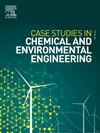低质量橡胶废料热解制备液体生物燃料的理化性质
Q1 Environmental Science
Case Studies in Chemical and Environmental Engineering
Pub Date : 2024-12-26
DOI:10.1016/j.cscee.2024.101085
引用次数: 0
摘要
本研究探索了低质量橡胶废料作为通过热解生产液体生物燃料的原料的潜力,实现了65 - 70%的转化率。本研究采用FT-IR、1H和13C NMR以及GC-MS技术对废橡胶热解油(WRPO)进行了综合分析,以确定其化学成分和燃料性质。FT-IR分析揭示了一个复杂的饱和和不饱和碳氢化合物、芳香环和含氧化合物的混合物,而核磁共振分析证实了WRPO的多种化学结构。GC-MS鉴定的关键化合物包括d-柠檬烯、邻苯二甲酸二甲酯、十六酸甲酯和油酸甲酯,饱和烃含量为18.49%,不饱和烃含量为81.51%。TGA结果表明,WRPO具有与B10柴油相似的蒸发和热分解特性,在40°C以下开始蒸发,在300°C完全分解,突出了其作为高效环保生物燃料的潜力。燃料性能测试表明,WRPO的运动粘度为1.47 cSt,密度为785 kg/m3,具有良好的低倾点和云点(< - 5°C),适用于寒冷气候。然而,与B10柴油(11083 kcal/kg)相比,WRPO的热值为9675 kcal/kg,酸值高达4.24 mg KOH/g,可能导致氧化和腐蚀。总之,WRPO作为一种生物燃料显示出相当大的前景,但如果与B10柴油、棕榈油生物柴油或废食用油生物柴油等高能量燃料混合,将有利于提高其稳定性、燃烧效率和热值。这种混合策略增强了WRPO在可持续生物燃料生产和发动机使用方面的潜力。本文章由计算机程序翻译,如有差异,请以英文原文为准。

The physicochemical properties of liquid biofuel derived from the pyrolysis of low-quality rubber waste
This research explores the potential of low-quality rubber waste as a feedstock for liquid biofuel production via pyrolysis, achieving a conversion rate of 65–70 %. The study presents a comprehensive analysis of waste rubber pyrolysis oil (WRPO) using FT-IR, 1H and 13C NMR, and GC-MS techniques to identify its chemical composition and fuel properties. FT-IR analysis reveals a complex mixture of saturated and unsaturated hydrocarbons, aromatic rings, and oxygenated compounds, while NMR analysis confirms the diverse chemical structure of WRPO. GC-MS identifies key compounds, including d-Limonene, Dimethyl phthalate, Methyl hexadecanoate, and Oleic acid methyl ester, with 18.49 % saturated hydrocarbons and 81.51 % unsaturated hydrocarbons. The TGA results show that WRPO exhibits evaporation and thermal decomposition characteristics similar to B10 diesel, with evaporation beginning below 40 °C and complete decomposition at 300 °C, highlighting its potential as an efficient and environmentally friendly biofuel. Fuel property testing reveals WRPO has a kinematic viscosity of 1.47 cSt, a density of 785 kg/m3, and favorable low pour and cloud points (<−5 °C), making it suitable for cold climates. However, WRPO has a lower heating value of 9675 kcal/kg compared to B10 diesel (11083 kcal/kg) and a high acid number of 4.24 mg KOH/g, which may lead to oxidation and corrosion. In conclusion, WRPO shows considerable promise as a biofuel but would benefit from blending with higher-energy fuels, such as B10 diesel, palm oil biodiesel, or waste cooking oil biodiesel, to improve its stability, combustion efficiency, and heating value. This blending strategy enhances WRPO's potential for sustainable biofuel production and engine use.
求助全文
通过发布文献求助,成功后即可免费获取论文全文。
去求助
来源期刊

Case Studies in Chemical and Environmental Engineering
Engineering-Engineering (miscellaneous)
CiteScore
9.20
自引率
0.00%
发文量
103
审稿时长
40 days
 求助内容:
求助内容: 应助结果提醒方式:
应助结果提醒方式:


